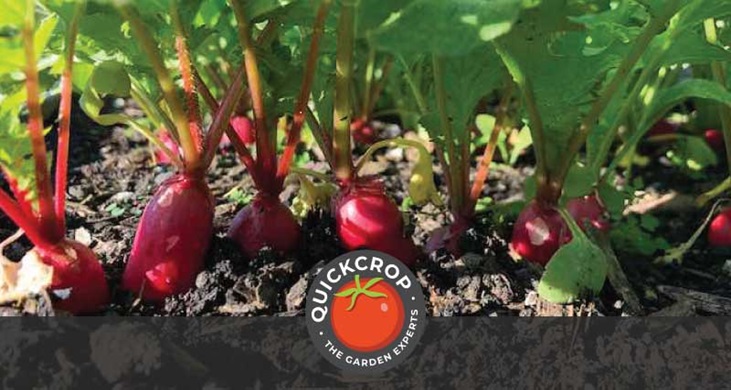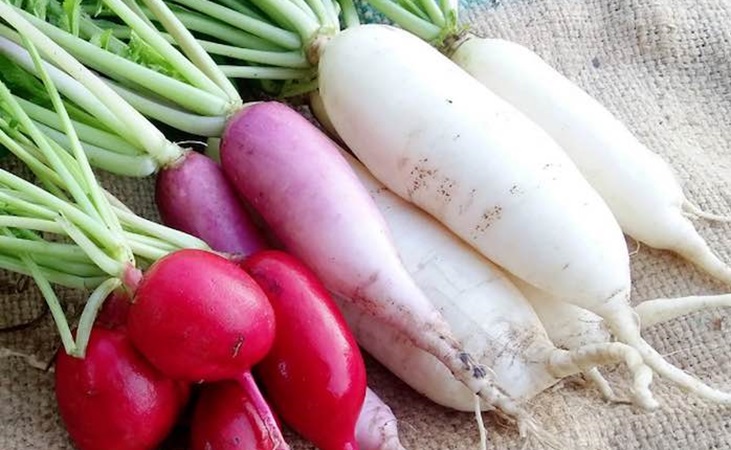How To Grow Radishes

Most people think of a small, round, pink variety when picturing a radish, usually either sliced or added whole to a garden salad. You may also remember the humble radish cut in an 'artistic' fashion and added as a garnish to any number of 1970's dishes. I'm not sure you were even supposed to eat them.
In reality though, radishes are available in a range of shapes, sizes, colours and flavours, and they can be prepared and enjoyed in many more ways than simply plonked on a salad.

Radish 'Cherry Bell'
View ProductHow to Grow Radish
Radishes are a cool season vegetable that can mature very quickly. Radishes of all types prefer a light, nutrient rich soil with good drainage. Spring and autumn sowings like full sun, while summer sowings are better in partial shade (which helps discourage bolting).
Radish seeds germinate easily and should sprout in 3 to 4 days. Summer and Winter radishes are quite different, as winter radishes are a much larger and slower growing crop than their giddy summer cousins.

Planting Radishes
Radishes can be grown in modules if planted out within 2-3 weeks, but they are more successful when sown direct, where the relatively large seeds are easy to sow. They can be started very early in the spring as soon as the ground is relatively dry, and can be worked in again in late fall in cold frames.
Radishes can be squeezed in between other plants and are good at loosening and cultivating soil for slower sprouting vegetables, like carrots.

Daikon Radish
View ProductWinter and asian radishes: Avoid sowing in spring and early summer, as these varieties are likely to run to seed. Early to late summer is the most reliable time for the Asian radishes, while delaying till July is recommended for Winter varieties.
Winter varieties taste best if left in the ground during the winter, and can be protected with a mulch of straw or a layer of heavy duty horticultural fleece. In very wet areas it is better to lift and store in boxes of moist sand.

Heavy Duty Garden Fleece Rolls 2m x 100m
View ProductHow Should I Space Radish Seeds?
Sow small amounts 2.5cm apart in rows 15cm apart at a depth of 1.5cm. As soon as the seeds have germinated, thin out any excess plants to leave the required spacing. You’ll want at least 2 inches between plants, but seedlings can be thinned and eaten when they are an inch or two tall.
Radish Pests and Problems
- Cabbage Root Maggots are more of a problem in northern gardens, where they will tunnel into radishes.
- Cutworms can also feed on radishes.
- Flea beetles will make Swiss cheese of radish leaves, but won’t injure the bulb.

Insect Mesh Netting - 3.6m x 3m
View ProductMonitor to catch these insects before they destroy the whole crop. You can avoid them almost entirely by growing your radishes under row covers or protection mesh.
Another organic control method for the flea beetle is as follows: Wave a treacle coated piece of card above the effected plants. The beetles will jump when disturbed, and find themselves glued to the sticky card rather than escaping to a neighbouring plant.

Radishes decline in quality when the temperature warms. They can get tough and woody or spongy, with hollow centers. Once a radish bolts - or goes to seed - the bulb stops forming.
Harvesting Radishes
Spring Radishes: The fast-maturing round radishes are ready for harvest in 3-4 weeks. You’ll usually see the top portion of the radish poking up through the soil. When it appears to be almost an inch across, it is ready to pick.
Radishes can be harvested by pulling or by gently loosening the surrounding soil. Don’t let mature radishes sit in the ground, or they will get either woody or spongy.
To keep a supply of fresh radishes throughout the season, sow small quantities every two weeks.
Winter Radishes: The long, Asian radish varieties take longer to mature: sometimes up to 3 months. They should be harvested before the ground freezes and can be stored for several months.
The thinned plants of all varieties can be used as salad greens or on sandwiches or floating on soups.
